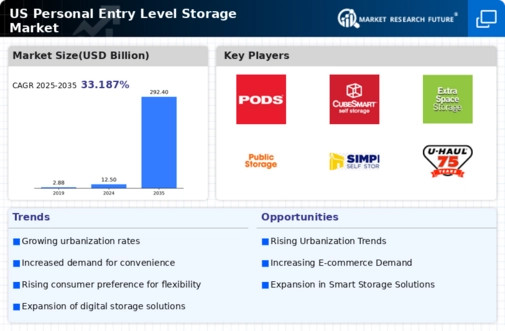Increased Data Generation
The personal entry-level-storage market experiences growth due to the exponential increase in data generation across various sectors. With the proliferation of digital devices, individuals are creating vast amounts of data daily. According to recent statistics, the average person generates approximately 1.7 MB of data every second. This surge in data necessitates efficient storage solutions, driving demand for personal entry-level-storage options. As consumers seek affordable and accessible means to manage their data, the market is likely to expand. The personal entry-level-storage market is thus positioned to benefit from this trend, as users require reliable storage solutions to accommodate their growing data needs.
Technological Advancements
Technological advancements play a pivotal role in shaping the personal entry-level-storage market. Innovations in storage technology, such as solid-state drives (SSDs) and cloud storage solutions, have enhanced performance and reliability. These advancements have made personal storage devices faster and more efficient, appealing to consumers seeking high-quality options. The personal entry-level-storage market is likely to benefit from these developments, as consumers increasingly prioritize speed and reliability in their storage solutions. As technology continues to evolve, the market may witness the introduction of new features that further enhance user experience and drive demand.
Growing Remote Work Culture
The shift towards remote work has significantly impacted the personal entry-level-storage market. As more individuals work from home, the need for reliable data storage solutions has intensified. Many remote workers require personal storage options to manage work-related files and personal data efficiently. The personal entry-level-storage market is adapting to this trend by offering products that cater to the unique needs of remote workers. This shift is expected to drive sales, as individuals seek to create organized digital environments. The market may continue to evolve, reflecting the changing dynamics of work and data management.
Affordability and Accessibility
Affordability remains a crucial driver in the personal entry-level-storage market. As prices for storage devices decrease, more consumers can access these technologies. Recent data indicates that the average price of entry-level storage solutions has dropped by approximately 20% over the past few years. This trend makes it feasible for a broader audience to invest in personal storage solutions. The personal entry-level-storage market is likely to see increased adoption rates as consumers prioritize cost-effective options. Furthermore, the rise of online retailers has enhanced accessibility, allowing consumers to purchase storage devices conveniently, further propelling market growth.
Rising Awareness of Data Security
As data breaches and cyber threats become more prevalent, awareness of data security is rising among consumers. This heightened concern drives individuals to seek personal storage solutions that offer enhanced security features. The personal entry-level-storage market is responding to this demand by incorporating advanced security measures, such as encryption and password protection, into their products. Recent surveys indicate that approximately 60% of consumers consider data security a top priority when selecting storage solutions. This trend suggests that the market may continue to grow as consumers prioritize secure storage options to protect their valuable data.























Leave a Comment